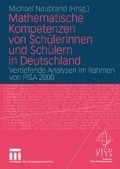Zusammenfassung
In diesem Beitrag wollen wir uns mit beobachtbaren Indikatoren beschäftigen, die eventuell einen Einfluss auf Aufgabenschwierigkeiten (im Folgenden auch Itemthresholds genannt) haben.
Access this chapter
Tax calculation will be finalised at checkout
Purchases are for personal use only
Preview
Unable to display preview. Download preview PDF.
Literatur
Adams, R., & Carstensen, C. (2002). Scaling outcomes. In R. Adams & M. Wu, PISA 2000 Technical Report (pp. 149–162 ). Paris: OECD.
Baumert, J., Klieme, E., Neubrand, M., Prenzel, M., Schiefele, U., Schneider, W., Stanat, P., Tillmann, K.-J., & Weiß, M. (Hrsg.). (2001). PISA 2000. Basiskompetenzen von Schülerinnen und Schülern im internationalen Vergleich. Opladen: Leske + Budrich.
Draba, R. E. (1977). The identification and interpretation of item bias. Chicago: University of Chicago (Research Memorandum 26 ).
Fischer, G., & Molenaar, I. W. (Eds.). (1995). Rasch models: Foundations, recent developments and applications. New York: Springer.
Knoche, N., Lind, D., Blum, W., Cohors-Fresenborg, E., Flade, L., Löding, W., Möller, G., Neubrand, M., & Wynands, A. (Deutsche PISA-2000-Expertengruppe Mathematik). (2002). Die PISA-2000-Studie, einige Ergebnisse und Analysen. Journal für Mathematik-Didaktik, 23 (3/4), 159–202.
Lord, F. M. (1980). Applications of item response theory to practical testing problems. Hillsdale, NJ: Erlbaum.
Neubrand, M., Klieme, E., Lüdtke, O., & Neubrand, J. (2002). Kompetenzstufen und Schwierigkeitsmodelle für den PI SA-Test zur mathematischen Grundbildung. Unterrichtswissenschaft, 30 (2), 100–119.
Stanat, P., & Kunter, M. (2001). Geschlechterunterschiede in Basiskompetenzen. In J. Baumert, E. Klieme, M. Neubrand, M. Prenzel, U. Schiefele, W. Schneider, P. Stanat, K.-J. Tillmann, & M. Weiß (Hrsg.), PISA 2000. Basiskompetenzen von Schülerinnen und Schülern im internationalen Vergleich (S. 249–269 ). Opladen: Leske + Budrich.
Thissen, D., Steinberg, L., & Wainer, H. (1993). Detection of differential item functioning using the parameters of item response models. In P. Holland & H. Wainer (Eds.), Differential item functioning (pp. 67–113 ). Hillsdale, NJ: Erlbaum.
Wang, W.-C. (2000). The simultaneous factorial analysis of differential item functioning. Methods of Psychological Research Online, 5 (1), 57–75.
Wu, M. L. (1998). ACER ConQuest: Generalised item response modelling software manual. Melbourne: ACER.
Editor information
Rights and permissions
Copyright information
© 2004 VS Verlag für Sozialwissenschaften/GWV Fachverlage GmbH, Wiesbaden
About this chapter
Cite this chapter
Knoche, N., Lind, D. (2004). Eine differenzielle Itemanalyse zu den Faktoren Bildungsgang und Geschlecht. In: Neubrand, M. (eds) Mathematische Kompetenzen von Schülerinnen und Schülern in Deutschland. VS Verlag für Sozialwissenschaften. https://doi.org/10.1007/978-3-322-80661-1_5
Download citation
DOI: https://doi.org/10.1007/978-3-322-80661-1_5
Publisher Name: VS Verlag für Sozialwissenschaften
Print ISBN: 978-3-531-14456-6
Online ISBN: 978-3-322-80661-1
eBook Packages: Springer Book Archive

